Leucopaxillus spp.
Leucopaxillus is another mushroom that, like Cortinarius, looks big, fleshy, and tasty, but is altogether inedible. The main variety that occurs in Arizona has a yellow-tan cap and gets the common name, "toasted marshmellow mushroom". You can expect to find these on any late summer-fall foray, and may find them in great numbers.
Leucopaxillus are litter decomposers and typically will be on the forest floor or in grass where leaf litter falls. It is common to see a disc of white spread underneath their large caps where spores have been raining down.
Here are some useful characteristics to help identify them:
- Large and fleshy with a thick stem and an inrolled cap margin.
- Very tough and rubbery
- Flat, tan-yellow caps that are often mottled or cracked
- White sporeprint, often visible in the duff below the cap.
- Extremely bitter if you nibble the cap
- You may find the base of the stem surrounded by thick mycelium. If picking from leaf litter, a clump of litter bound together by mycelium often comes up with it.
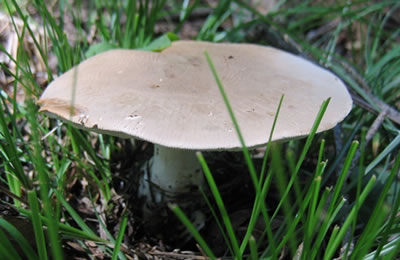
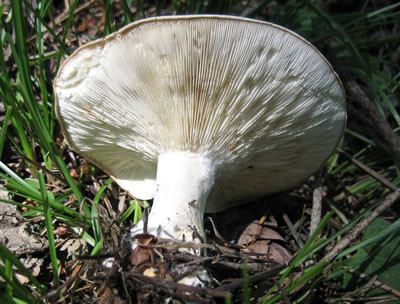
Lobster mushrooms
- Hypomyces lactoflorum.
Lobster mushrooms are a fascinating departure from what we typically consider mushrooms. They are, in fact, Russulas and Lactarius that have been parasitized (lobsterized?) by a microscopic ascomycete. This ascomycete, Hypomyces, catches the mushroom in its early development and transforms the tissues into its own spore delivery system. For H. lactoflorum, the process deforms the mushroom, the outer surfaces become lined with bright red-orange microscopic spore-filled flasks, and the tissues become edible regardless of the original chemistry.
There are other members of Hypomyces that attack other mushrooms such as boletes, and there is also a variety that will turn Russulas green. None of these are edible.
You have a chance of finding lobster mushrooms wherever you find Russula and Lactarius. And where there is one transformed Russula, there is a good chance there are others. The great thing about lobster mushrooms is that they are basically failsafe: you simply can not mistake them for anything else. In the transformation process, the flesh becomes quite firm and dense, which makes it even harder to mistake lobsters for anything else. Just be sure that what you have is a deformed mushroom and not a perfectly healthy inedible orange mushroom, like Gomphus floccosus!
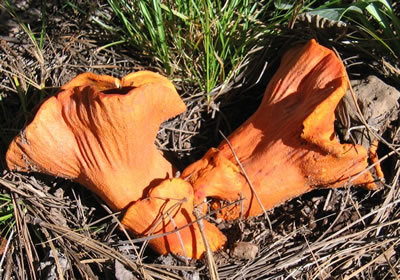
The brilliant orange, unmistakable lobster mushroom.
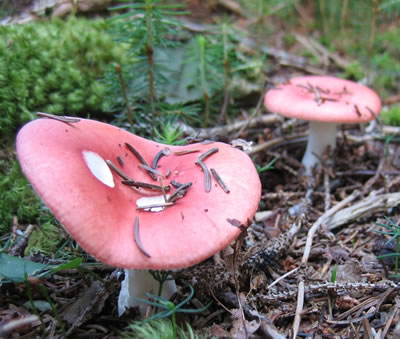
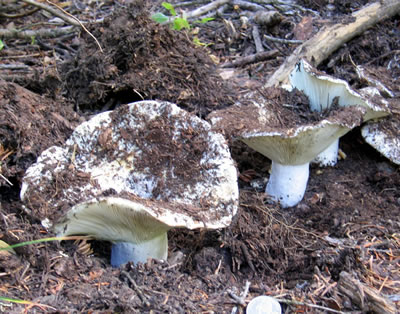
Don't forget that the Lobster Mushroom fungus parasitizes members of Russula and Lactarius. If you find either of them, keep an eye out for lobsters!
Oyster mushrooms
- Pleurotus ostoyae
Oyster mushrooms are an excellent edible mushroom that can be found throughout Arizona. They are magnificent wood decomposers, able to attack fresh wood and fend off competitors with potent antibiotic and antifungal metabolites.
Few mushrooms can compete with the great flavor and firm texture of oyster mushrooms. Oysters are one of the few wild mushrooms that are commonly cultivated for commercial sale; you should be able to find them at high-end grocery stores and sometimes even in standard stores. In my experience, fresh oysters from the field are exponentially superior to anything you can buy. They are worth any degree of effort spent in hunting them down.
Hunting oyster mushrooms poses a few major issues:
- While they are common, it is rare to find large oysters.
- If you do find large oysters, they have often already been nibbled down by insects, or are insect-riddled.
- There are a wide variety of inedible lookalikes that are far more common than oysters!
It is unfortunate that such a wonderful, tasty mushroom has so many inedible / sickening lookalikes. That issue is what keeps oysters out of my AZ fab four.
False oysters often have a characteristic that sets them apart from true oyster mushrooms:
they are more pigmented, not translucent, have non-white spores, and/or lack stems. Here is a list of oyster lookalikes that you should be familiar with if you want to dare harvesting oyster mushrooms:
- Crepidotus
- Gymnopilus
- Lentinellus
- Omphalotus
- Panus and Panellus
- Tapinella (Paxillus)
That said, here are the primary characteristics of oyster mushrooms:
- Often occur on dead aspen, but can sometimes be found on dead conifers.
- Translucent flesh. Dry specimens are only mildly so.
- White / translucent gills and flesh
- Smooth surfaces (not hairy!!!)
- Have a short, thick stem, but gills run down the stem.
- White sporeprint
- Distinct "pleurotis" aroma. Decaying wood behind the mushrooms will have a "licorice / anise" aroma.
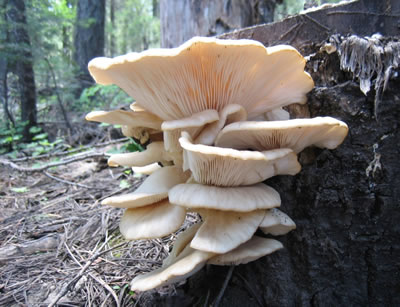
Oyster mushrooms of ideal size and maturity. Note their translucent flesh. You can't tell from the photo, but oysters always have a short stem attached to their host material.
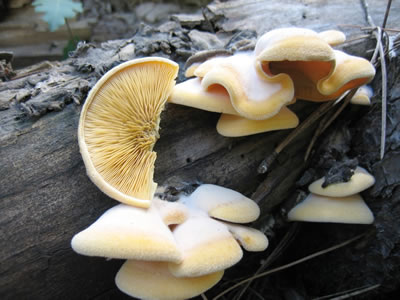
These lookalikes (Phyllotopsis nidulans, the mock oyster)
were on a log immediately next to the oysters in the above photo. You must always closely scrutinize your "oysters" to be completely sure they are the real deal.
Pholiota sp.
Pholiota is a common decomposer of fresh wood in Arizona. It is spectacularly colored and ornamented, and often produces large clusters where it appears. Any wood is fair game for Pholiota; I have seen it attacking both conifer and Aspen. It is not uncommon to find clusters of Pholiota appearing up to 10' high on standing dead trees, but it is just as happy to attack logs, debris, and sometimes buried wood and roots. It is not a pathogen in Arizona, however, so only acts on dead wood.
Pholiota is a flamboyant fungus. It forms large orangish-tan-brown clusters, and is often fully covered in large scales. Its spores are rusty brown and produced in great abundance. One common species smells of garlic. In certain places, especially where there has been thinning, treefall, etc., Pholiota can be present in great abundance.
In Arizona, only one member of Pholiota is potentially edible: Pholiota squarrosa. You will know P. squarrosa when you find it; it smells strongly of garlic! This species can be very abundant, and certainly seems to be a great candidate for the table due to its size, but I can't recommend it. Most field guides stress caution or simply list it as inedible. I have seen a few foragers collect it, but only once...
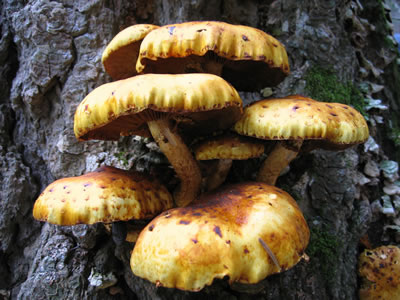
Pholiota aurivella on a dead Ponderosa Pine.
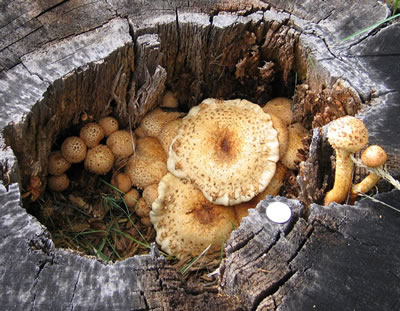
Pholiota squarrosa in this large Ponderosa trunk. Notice the quarter placed on the trunk for scale.
Puffballs
Puffballs are one of my Arizona fab four edible mushrooms because of their ease of identification and great quality (and quantity). Puffballs are detritus decomposers, occuring both on the ground and on well rotted wood. As a puffball matures, its tissues transform into a spore mass. Prior to this transformation, the interior is pure white, firm, and edible. It is necessary to check every puffball for whiteness and discard any that are discolored (also check to be sure you don't have an undeveloped Amanita egg!). You can perform this check as you prepare them for cooking.
- Lycoperdon spp.
Essentially, Lycoperdons are the small puffballs. Typically they are about the size of a quarter or fifty-cent piece. The two most common small puffballs you can expect to find are the pear-shaped puffball (L. pyriforme) and the studded puffball (L. perlatum). These puffballs can be found almost anywhere that recieves decent precipitation and has at least some humus. We have found them in forest, on forest roads, and ski slopes.
- Calvatia spp.
Calvatia are the giant puffballs of great fame. Some can reach soccer-ball size and larger. Typically, the giant puffballs are found in open areas such as meadows and forest clearings, and in Arizona, only at high elevations. Giant puffballs tend to be a beacon for insects, so catching them early is important.
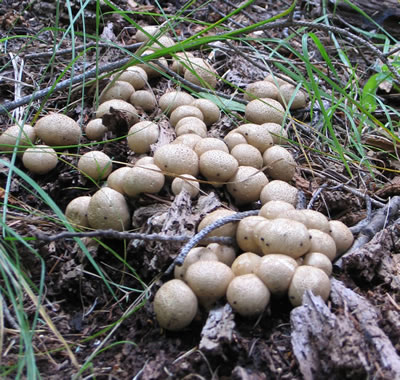
A cluster of L. pyriforme along a well-rotted log.
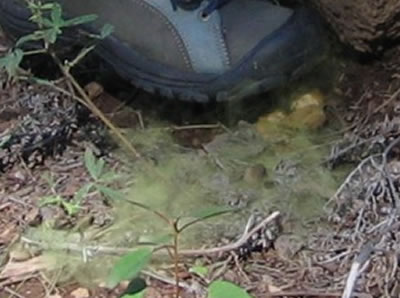
Fully mature puffballs may not be edible, but they are certainly entertaining.
Shaggy manes and other inky caps
Inky caps are a unique group of mushrooms that disperse their spores by autodigesting their gills into a black "ink". This spore-laden ink is then washed away by rain. Because of this character, inky caps must be prepared within 8 hours of harvesting. As goes without saying, mature specimens are undesirable for collecting.
Please note that the term, "inky cap", referrs both to the genus Coprinus in general, and to its best known member, C. atramentarius.
Shaggy mane
- Coprinus comatus
The shaggy mane is an unmistakable member of my Arizona fab four edible mushrooms. Its size, color, and appearance make it hard to miss and easy to identify. Shaggy manes typically occur in groups, and often individuals in the group are at different levels of maturity. Only the immature "uninked" specimens should be collected.
Shaggy manes have an unusual colonization pattern, and tend to appear in grass along trails and roadsides. My guess is that their spores are taken up by grazers and deposited in dung. It is extremely uncommon to find shaggy manes within forests. Once you have located a patch of shaggy manes, you can often return to it for several more years.Catching the fruitings at the right time is the real challenge.
Inky cap
- Coprinus atramentarius
C. atramentarius is the classical inky cap, and was used historically as an actual source of ink! These inky caps often do occur in forested areas at the base of dead trees and stumps. Typically, inky caps in Arizona act as secondary wood decomposers, acting on a previous round of decomposition conducted by more powerful, obligate wood rotters. I have only found inky caps acting as secondary wood rotters, but they should be capable of decomposing a wide range of materials.
There are several inky cap lookalikes, but a few easily checked characters will clearly identify your specimens:
- Inky caps (including shaggy manes) have very closely packed gills, leaving almost no space between them
- Members of Coprinus almost always have grey or slightly tan tissue, and grey gills that blacken with age.
- Obviously, the presence of mature, inky specimens will solve the mystery.
A final note on inky caps: While both the shaggy mane and the inky cap are edible, C. atramentarius contains a compound called coprine that disables the liver's ability to decompose alcohol. If you are going to eat C. atramentarius, you should not consume alcohol for 5 days after.
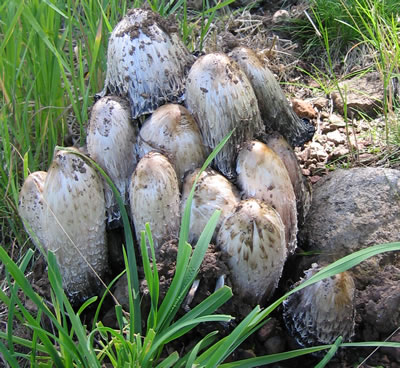
A cluster of maturing shaggy manes near a gravel access road.
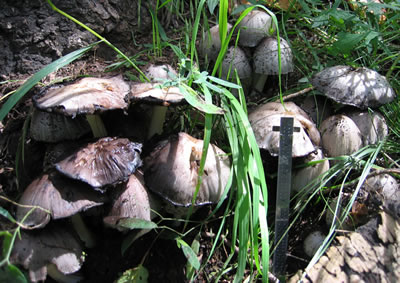
These inky caps were unusually large! The ruler is 6" tall!
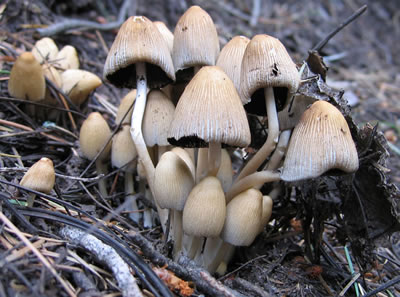
Some common lesser inky caps.
Probably mica caps (C. micaceus)
The Velvet Foot
- Flammulina velutipes and F. popucola
The latin, velutipes, translates to "velvet foot". The velvet foot gets its name from the drastic color and texture change along its stem. As you can see in the photo to the right, the stem is light tan near the cap, but becomes darker as it approaches the base. This color change is accompanied by a change in texture: it becomes velvety.
Arizona hosts a sister species of F. velutipes: F. popucola. This species is so named because it is specifically found at the base of dead or dying aspen: members of the Poplar genus.
F. popucola is quite common in Arizona and fruits often. It is often the first and the last mushroom of the season. As noted above, you will find it at the base of dead or dying aspens.
Caution is advised when collecting the velvet foot, as there are a good share of other small, clustering mushrooms that have similar color changes along the stem. You need to take note of the following important characteristics:
- Occurs at the base of dead or dying aspen, with stem bases not connected to wood at a point above ground level.
- Cap is tan, with lighter colored outer edge
- Cap becomes slimy when wet
- Gills are cream colored
- Sometimes the cap and gills appear "pinched" at one end
- White sporeprint.
- Stem is tan near the cap, then darkens and becomes velvety further down.
- Occurs in clusters
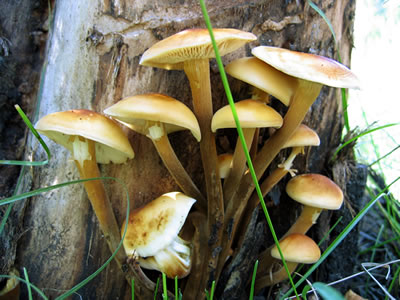
A cluster of Velvet foot (feet?) at the base of a dead aspen.
There is one other place you can find the velvet foot in Arizona: in high-end grocery stores! F. velutipes is cultivated in dark, oxygen starved chambers, which makes it produce white, long stemmed clusters. In this form, it is sold as Enotake. I have seen it at AJ's, Whole Foods, Sprouts, and asian markets.